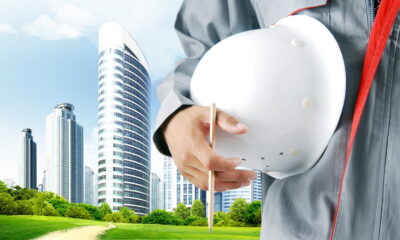

Features
Revolving Doors Are The Most Eco-Friendly And Practical Option
The National Association of Realtors published a very sobering article last year on green homes. They pointed out that as Americans become more concerned about sustainability and fighting climate change, green homes have become more popular. Unfortunately, the number of people that actually live in green homes is much lower.
The NAR said that only 121,400 homes are LEED certified. Homeowners need to evaluate every part of their home to make them greener. One thing to look at is whether you have revolving or automatic doors.
Revolving Doors are Ideal for Sustainable Homeowners
There are a lot of options to consider when building a green home. The doors are an important feature.
While both automatic and revolving doors have the same functions, they’re both completely different designs. Some people would argue that automatic doors are the superior doorway design.
However, revolving doors offer better solutions for building owners and for people living or working in the building. Both designs also have different functions depending on the building. For example, banks need more security so automatic doors are not ideal for this type of application.
But the green benefits are most frequently ignored. Revolving doors don’t require electricity, so they don’t leave nearly as high of a carbon footprint.
So, what do you think is the more superior design for a green home? Let’s see how you feel about the two designs after reading this article. We will consider various factors in addition to sustainability.
3 Types of Door Solutions
There are three types of door designs that can be used. These designs have specific functions meant for different applications. Using the correct kind of door solutions solely depends on the type of building it’s integrated into.
The region of the building also has a major impact on finances and how much energy is used. Take a look at the three different door solutions there are and what applications they are used for.
1. Sliding Doors Designs (Automatic)
There are approximately three types of sliding doors:
- The single sliding door
- Bi-part
- Telescopic
For single sliding doors the walkthrough is offset. For the Bi-Part sliding door, the walkthrough is centred. Telescopic sliding doors are designed for confined spaces, usually in an office or as a doorway to a car showroom.
Sliding Door Key Applications
Sliding doors are quite popular as they’re used for most malls and grocery store buildings. They allow for larger walk throughs for places that have high foot traffic.
The sliding doors are usually automatic. A sensor will detect when a person is nearby to allow the doors to open automatically.
2. Swinging Doors Designs
A swinging door can be opened in either direction. There is a spring device attached to the door to allow it to swing shut when activated. Swinging doors aren’t usually automatic so they can be used for myriads of applications.
Swinging Door Key Applications
Swinging doors are made from different types of materials such as wood or glass, depending on the application they’re used for. The swinging door can either be a double or single design.
Swinging doors aren’t popular for offices or buildings with heavy foot traffic. It’s not ideal for two-way traffic and doesn’t have many security measures to accompany the design. They’re usually used for kitchen doorways in houses or in restaurants.
3. Revolving Door Design
Revolving doors consist of either three or four panels of framed glass that rotate on a cylinder. The glass is robust and soundproof while the frames have an airtight seal around the edges of the glass panels.
Revolving Door Key Applications
The revolving door is quite versatile and can be used on many types of buildings such as hotel lobbies, bank entries & airport entries. Depending on what type of building it is the revolving door may only be a one-way application.
The one-way revolving doors are usually designed for banks and airports for added security. Standard revolving doors can be used to enter and exit the building quickly & easily. They are designed for places with heavy foot traffic such as office blocks and museums.
Automatic vs. Rotating Doors
Energy Performance
Since this is a green living blog, our emphasis is mostly on environmental benefits. Saving on cash is important to any business but being environmentally aware is just as imperative. Revolving doors are ideal for regions that have colder climates. The rotating panels are constantly moving so it’s impossible for any cold air to come through the doorway.
This is something that not enough environmental experts focus on. The World Green Building Council didn’t make any mention of revolving doors in their article on the benefits of green homes.
So how are revolving doors energy efficient? Because the design reduces cold airflow, there’s no need for heavy use of HVAC systems to control the temperature. Buildings can retain their heat easily because the doorway is always closed off thanks to the revolving panels.
In contrast, automatic doors or sliding doors don’t have the same feature. Automatic doors slide open either from the middle or the side every time a person approaches. The automatic design doesn’t save on electricity as you’ll need power in order for the automatic doors to function.
What’s more, an automatic door doesn’t reduce airflow through doorways. The design is not suitable for colder climates but may be ideal for warmer regions.
Traffic and Space
Revolving doors have large sections designed for large groups of people to enter at a time. Because of the revolving design, people can enter and exit easily without causing congestion. The design allows the foot traffic to flow in and out of the building easily.
The sections of the revolving doors are big enough to allow people with large bags and luggage to pass through without hassle. Revolving doors are also ideal for people using wheelchairs and crutches because the doors rotate easily with little effort from the person passing through.
Sliding doors are also designed to be a two-way application but note that it may get congested. The flow of foot traffic is reduced because people walk in all directions trying to get past one another when they’re in a hurry. Sliding doors are only ideal for places with minimum foot traffic.
Operational Consideration
If you’re looking for door solutions with optimal operational designs perhaps you need Advance Access to help you. High quality revolving doors are versatile because they can be used for any application. Security is easier and the costs of utilities are reduced.
Other considerations
If you’re thinking about what type of door solution would best suit your building perhaps go through the advantages of both automatic and rotating doors.
Opt for a spacious revolving door system to allow a flow of foot traffic. The revolving door is low maintenance, and you can integrate security solutions easily with the design. Integrating a revolving door onto your building will even pay for itself as it’s a major energy saving door solution.
What is your priority at the moment? They’re both optimal designs but one of them will have features ideal for your unique building.
Revolving Doors are the Eco-friendly Option
There are a lot of environmental benefits of revolving doors. They don’t use electricity and promote better airflow, which keeps the interior colder and requires less heat. You should invest in them if you are concerned about sustainability of your home.


 Environment9 months ago
Environment9 months agoAre Polymer Banknotes: an Eco-Friendly Trend or a Groundswell?

 Environment11 months ago
Environment11 months agoEco-Friendly Home Improvements: Top 7 Upgrades for 2025

 Features8 months ago
Features8 months agoEco-Friendly Cryptocurrencies: Sustainable Investment Choices

 Features9 months ago
Features9 months agoEco-Friendly Crypto Traders Must Find the Right Exchange





























